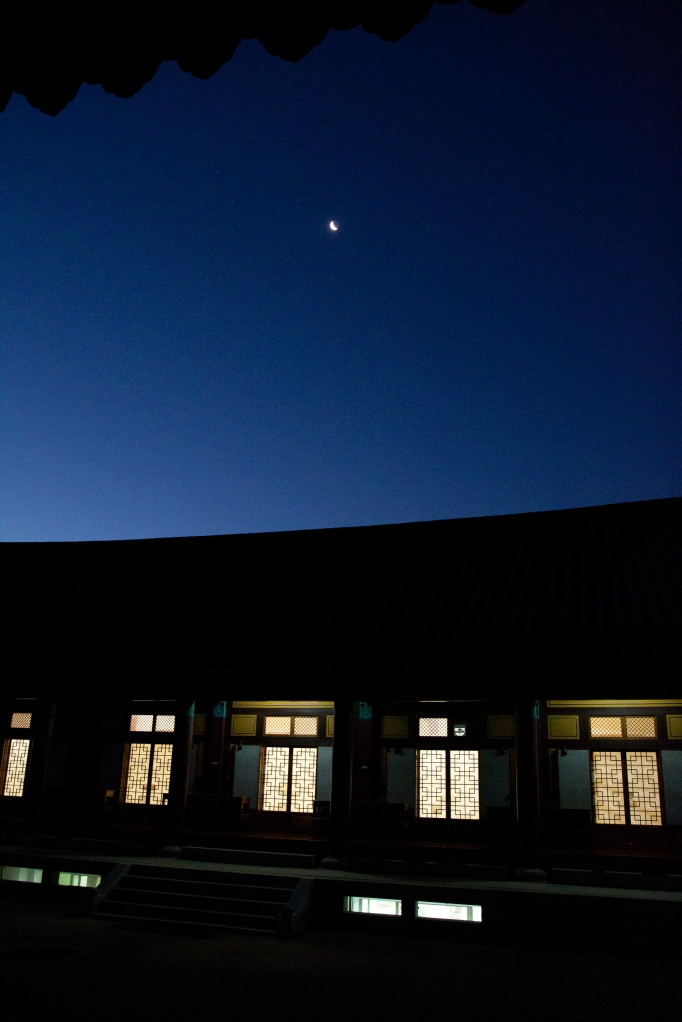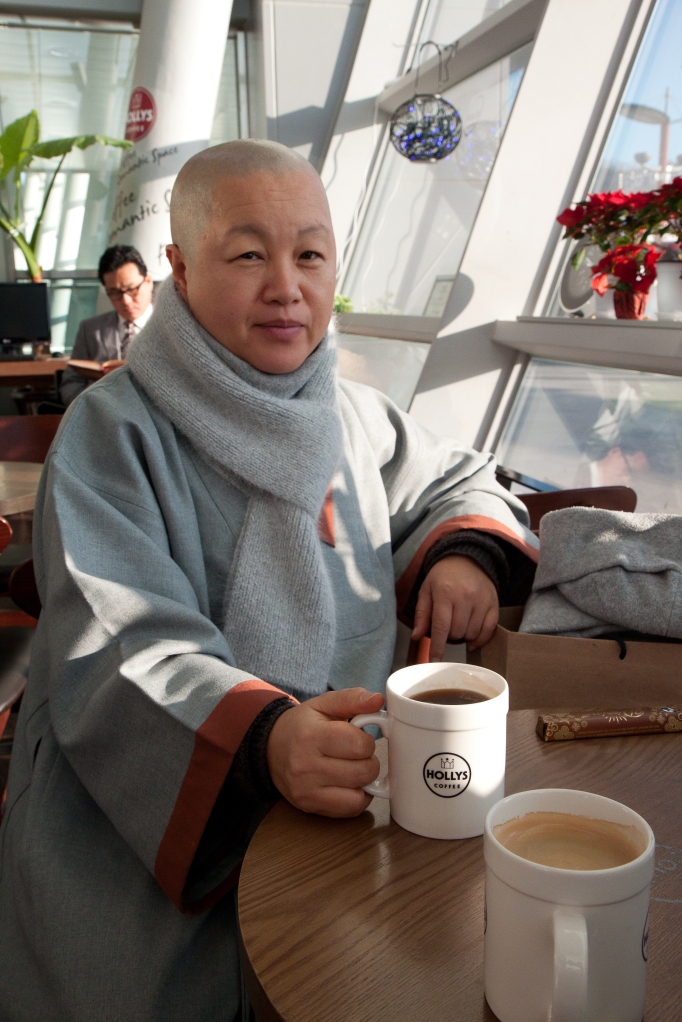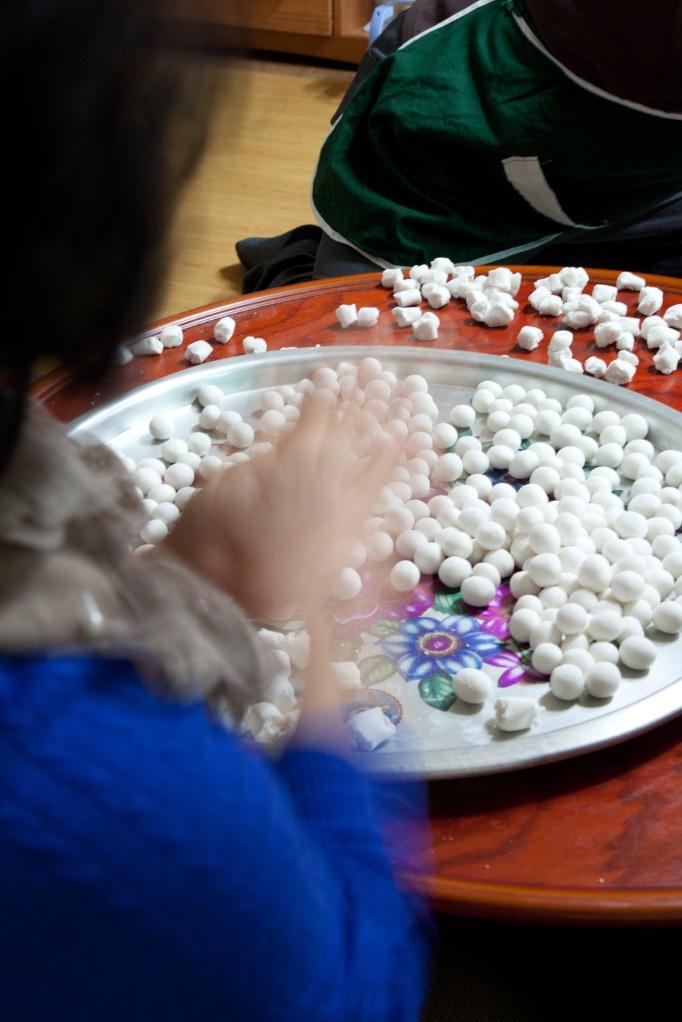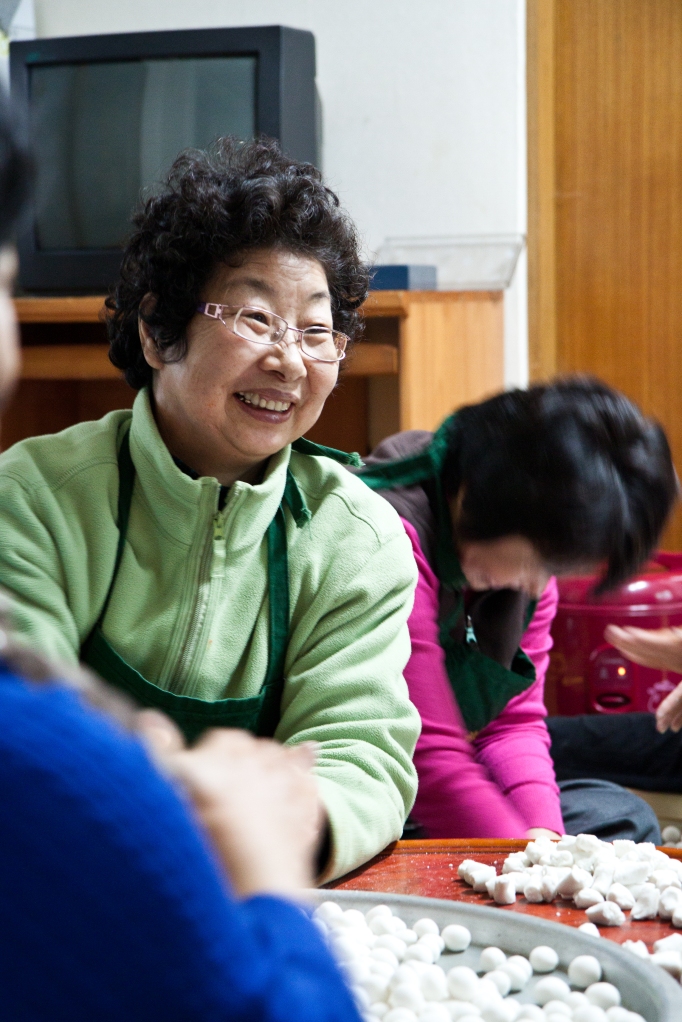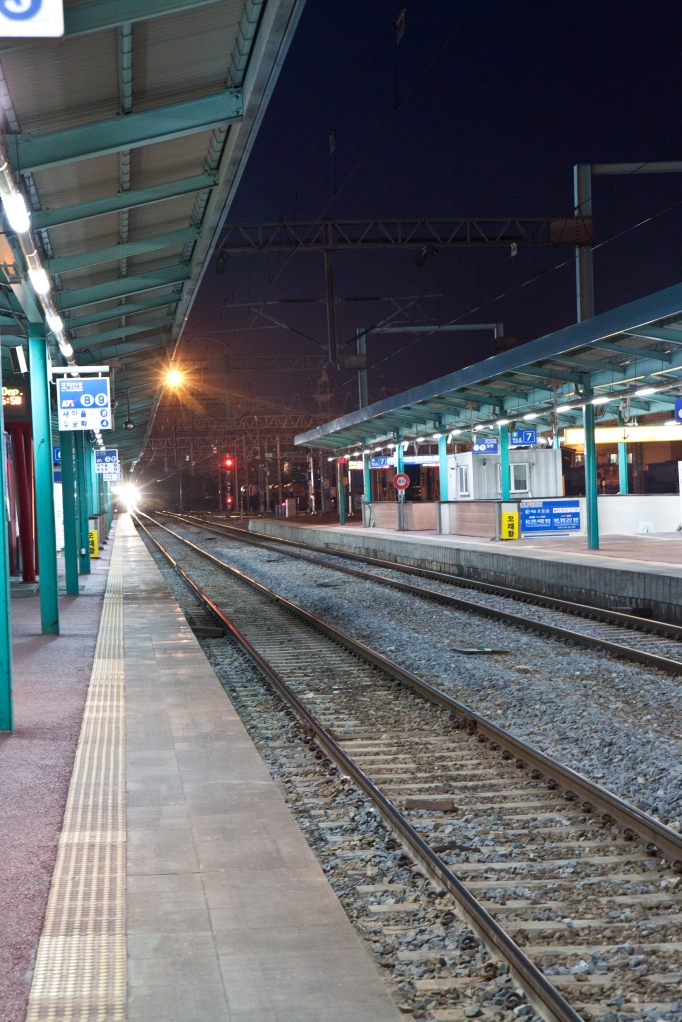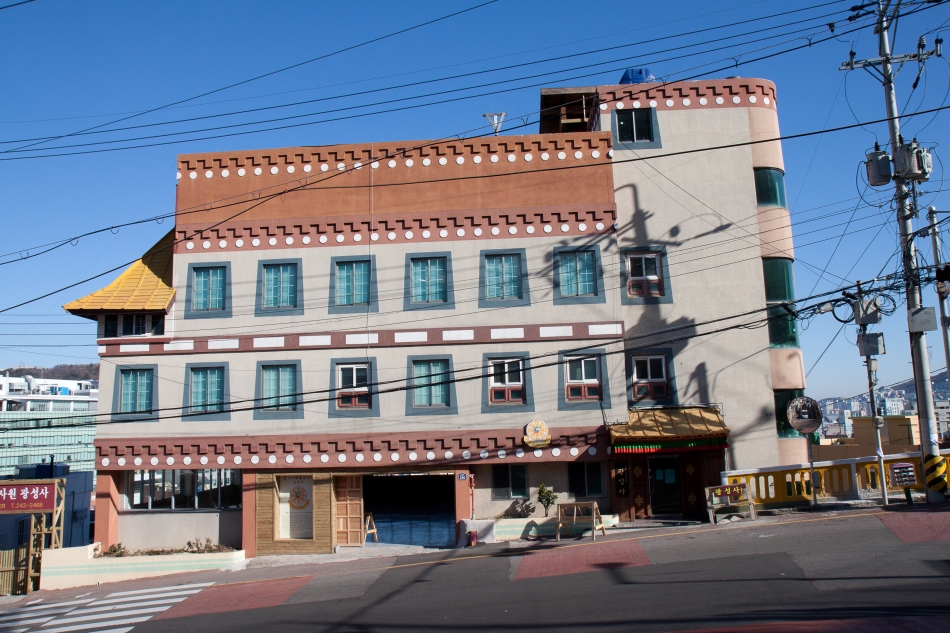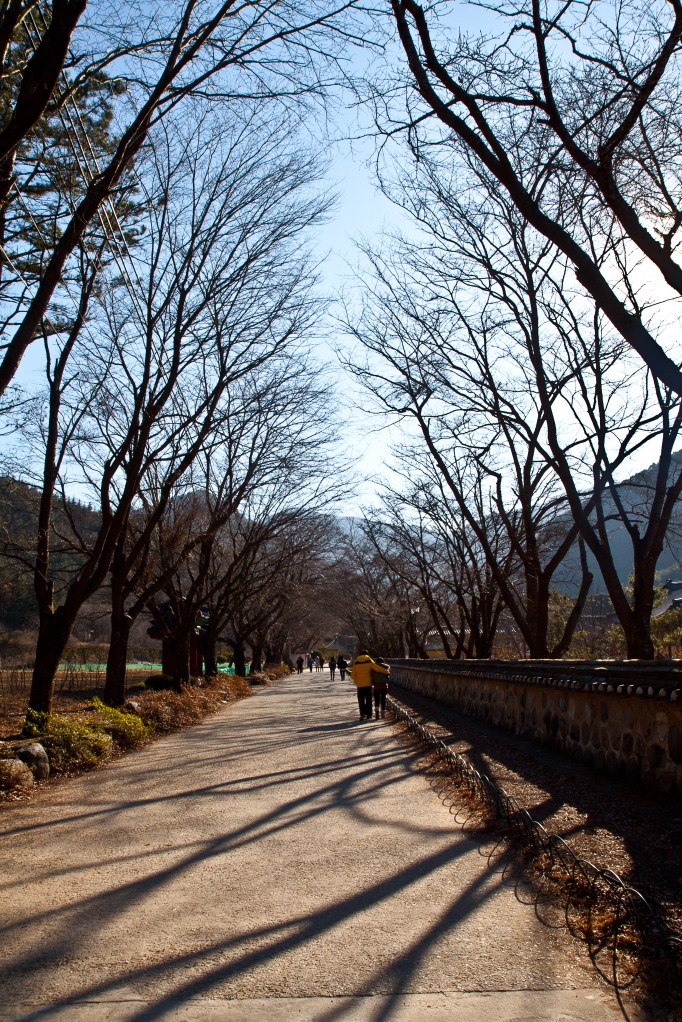the little new year
About 6 a.m., December 20th, looking toward “The Hall of Blue Winds,” or 청풍료, and Reclining Tiger Mountain, 호거산
One of the major differences between the monks’ and nuns’ seminaries in Korea is that the monks organize their school-year, including vacations, around the schedule of the Zen Halls: when the winter or summer retreat ends—and all the Seon monks are traveling—student-monks also go on vacation. The nuns’ vacations, however, correspond to the major holidays that occur each season. Someone told me the reason for this difference in schedules is two-fold: one, by having different vacations, it’s hoped that the sami and samini sunims won’t mingle. Two, bhikkuni temples in Korea rely more on the home temple’s monastic community to host celebrations, and we’re needed at home to help out with preparations and ceremonies.
And so, two days shy of the solstice, we emptied out into the indigo-blue dawn and scattered across the country. Solstice not being as large an event as Lunar New Year’s, Buddha’s Birthday, or the end of the summer retreat (Ullambana), some nuns receive permission from their teachers to go elsewhere for the four-day break. I personally had visa paperwork to take care of, as well as some organizing to do ahead of our impending graduation, so I went to my home temple and forewent any other plans.
Ji Mun Sunim and Hye Oh Sunim at the ticket counter at the Unmun-sa Bus Station, which doubles as a small convenience store.
Although I used to travel mostly by bus between school and home, not only does that mean three different buses and take the entire day, I get carsick. It turns out that I can catch the train at Ulsan Station, which is just over Unmun Pass, and make it back to Gunsan in North Jeolla Province faster, with only one transfer in Daejeon (although I do have to switch train stations, moving from the Gyeongsan Line to the Honam Line) than if I go by bus. I like trains. Unlike buses in Korea, which seem to swerve even more than the proliferation of mountain roads requires, trains move in swooping curves or sail on straightaways, in motions vaguely epic instead of dizzyingly nervous. Something about them soothes me; I like watching the scenery; I love the little country train-stations; and I never get trainsick, a major bonus. Additionally, that day I had to get up to Seoul to take care of business before heading back down toward the provinces, and the only way to get to Seoul and onto anywhere else in a day is if you go by high-speed train.
Heading “over the hill” with me were a few of my classmates. It struck me that this was, for most of us, the last bus to Ulsan we would ever ride together as students. It wasn’t melancholy, but it was poignant. All things arise, they abide, change, and fall away. A week from today, I will no longer be a student-nun, but a graduate.
Hyeon Oh Sunim enjoys a last coffee at Ulsan Station.
Hyeon Oh Sunim and Hye Oh Sunim waited for the train going in the opposite direction, toward Busan, and we stood waving goodbye to each over the tracks.
Waiting: 9:14 am.
Our trains had the exact same departure time, 9:22 am, but my train came into the station first. I boarded and settled down. The trip to Seoul Station would take roughly two hours, and I would get off the train during the lunch hour. I had to go to Jogye Order headquarters, to pick up my visa extension paperwork and ask about the exam for full precepts that I and another foreign monk will sit in the spring. I would find out only once I’d visited Jogye Order that both reasons for my trip to Seoul would be to no purpose: I can now download my paperwork off the Jogye Order website, and no special accommodations will be made or given for foreign monastics sitting the exam.
Picture of Kim Jong-eun in the Choson Ilbo, with a family tree showing all the descendants of Kim Il-sung below. I was surprised to see that each generation has typically had two or three wives, with numerous children; many are missing, leaving, as desired, only one clear line of inheritance to Kim Jong-eun.
Before I understood my trip’s double unnecessity, though, I waited out the 30 minutes remaining to the lunch break in the Social Bureau, looking over the Choson Ilbo. Kim Jong-il’s death had been announced the day before, and the news was all about him, North Korea, and Kim Jong-eun, his son and successor. Everywhere, everywhere, Kim Jong-il stared out at us. Kim Jong-il’s blank paper eyes looked out in eerie multiplicity from the layers of newspapers lined up for sale at the subway station kiosks. The TV news stations on at the train stations reported redundantly on North Korea’s announcement, the viewing of Kim Jong-il’s body, Kim Jong-eun’s public appearances, in a way that reminded me of a less hysteric but no less obsessed CNN.
Václav Havel, the former president of both Czechoslovakia and the Czech Republic, writer, poet, playwright, dissident, national hero and Nobel Peace Prize nominee,* died the same day North Korea announced Kim Jong-il’s death. I tried to talk about Havel with my classmates over coffee; they didn’t know who he was. East Europe, 1989, rung no bells, even though both nuns were in their late 40s and would, if anyone did, have reason to remember the events of 1989. But then again, the history I learned to hold close is the history of the West, the Cold War, eruptions of democracy; I learned to value history only as it related to the rhetoric and propaganda of my own country.
I waited in vain for something about Havel to appear on the TV. Even on the scrolling red news-strip at the bottom of the screen. Nothing. I saw nothing about him in the newspapers, either, and writing this now I feel vaguely Learian: Nothing, nothing, nothing.
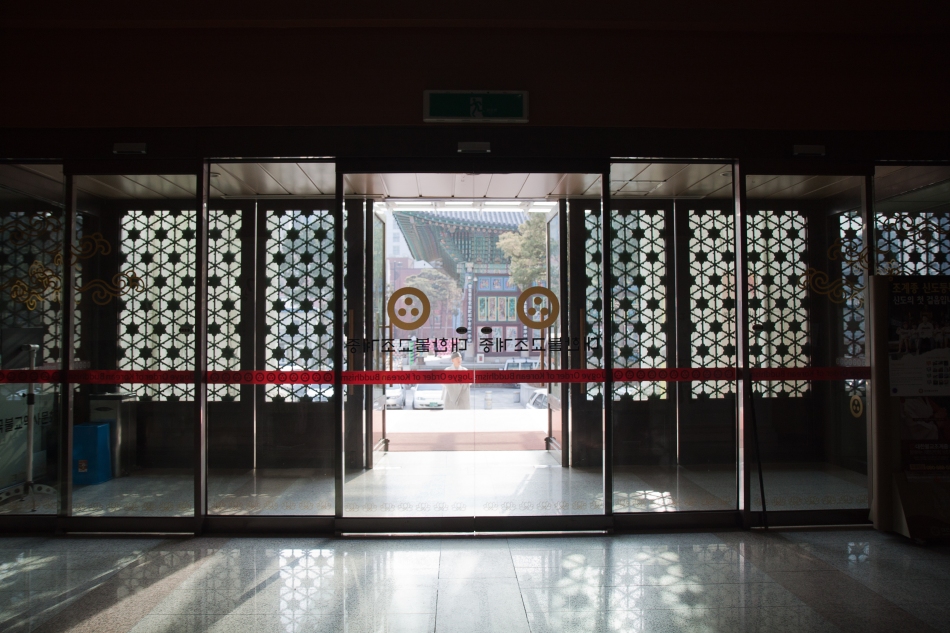
The doors of bureaucracy; in the background is Jogye-sa.
After the nice young man in the Social Bureau printed out the extension forms for me, I went down a floor and tried to talk the Education Bureau into allowing some kind of lee-way for foreign monastics who take the bhikku/bhikkuni exam and failing to elicit anything more than a bored dismissal, I left Jogye Order. I wasn’t looking for the usual lower standards for us; I was wondering if we could do something like, possibly, take the test in English. Not this year, it’s too late; but maybe in the future? I was the only one with any enthusiasm for the idea. I walked out the doors and down the avenue, toward Gwanghwa-mun. I went to Kyobo Bookstore, hoping to find Milan Kundera’s Unbearable Lightness of Being. They didn’t have it. I picked up a new translation of selected Tranströmer and The Best European Short Stories 2011 instead, in a mild pique. No Kundera! And nothing about Havel! Only dictators and military states and recalcitrant bureaucracies!
I went out for Indian food, hoping dal tarka and roti and masala tea might be good comfort food. It was. Then I went back to Seoul Station and got on a south-bound train, to go home for the solstice.
Preparing small dumplings of glutinous rice-flour, to go into the solstice porridge.
The next day we made ong-shim-i, the small round glutinous dumplings that go into the traditional red mung-bean porridge. Red, to drive away demons and evil energies. I’ve never heard anyone talk about winter solstice as a kind of All Hallow’s Eve, but why else would we be concerned about warding away evil spirits, if not because at the winter solstice the veil between the spirit world and the human world grew more traversable? Why not, unless it was because we humans, who are in the Korean world always available to the influences of spirits, are even more vulnerable at the solstice, the fulcrum of the balance between light and dark?
The ong-shim-i are made to represent the returning sun, the Abbess of our seminary told us before we went on vacation. She didn’t then equate the dark purple-red porridge with the night, and I also resist making that symbolic equivalence even though the image works nicely. No; red is for protection and blessing in East Asia, and that’s why we make solstice porridge out of red mung-beans.
Mun Bosalnim rolling ong-shim-i.
It’s not as easy as you’d think to roll nice round dumplings. Skilled hands can place up to three pinches of dough in the palm and roll them quickly to spherical sameness, without mashing any of the little lumps together. I tried three dumplings at a time, and couldn’t manage the task, so I kept it to two dumplings.
The bosalnims, our women congregants, took over the making of the actual porridge, a laborous process taking up to several days. The mung beans must be soaked, then boiled, then strained, then re-boiled. The thick paste sinks to the bottom of the enormous cast-iron cauldron we use and tends to burn if the fire’s too hot underneath it or it’s not stirred regularly enough. The basic porridge can be neither too salty nor too bland. People add either sugar or salt to their individual bowls later, at the table.
On the actual day of the solstice, we filled two hundred square Tupperware containers with the porridge (re-heated and with the dumplings added in). These were offered at the main altar, all the side-altars, the ancestors’ altar. I couldn’t take any pictures because I was working—as per the reason for our vacation in the first place, to help out—and then helping conduct the ceremony. (I hit the moktak.) We then handed out the containers to all those who came to the midday service. The actual solstice was in the afternoon, about 2:20, and the Abbess of our temple instructed everyone to recite the Heart Sutra over the porridge before sharing it with family and friends at home. I made a quick run to my local immigration office and filled out stage-one visa extension paperwork, then made it back home in time to help with the quick afternoon solstice ceremony. (I hit the moktak again and read name-cards for the blessing.)
That evening, preparing to leave the next morning, I arranged my room, but less carefully than usual. It was December 22nd, and in another two weeks—a graduate—I would be back in this room anyway. Major organizing could wait.
I usually take the 6:05 am bus, which I can either ride all the way to Daegu or, as I planned to do this time, ride it only to Iksan and then get back on the railway. I thought I would go to Busan before heading back to school, to visit Gwangseong-sa, the Tibetan temple I attend. Maybe Geshe Sonam, the abbot, would be home; and even if not, I could do my practices and say hello to Geshe Lobsang.
Gunsan Intercity Bus Terminal, picture taken summer 2011
The older lady who runs the convenience store in the bus station was already open at 5:30 am. I bought motion-sickness medicine. Even the 40-minute ride on straight roads through the rice and barely fields of North Jeolla makes me queasy. Better safe than sorry. The store-owner has been watching me leave for school before the sun is up at the end of every vacation for four years. We exchange pleasantries. She’s Catholic, but I tell her to come to temple sometime. She smiles and laughs, yes, yes.
Iksan Station, with the Seoul-bound KTX pulling up to the platform.
I caught the train bound for Seoul, got off in Daejeon and switched back to the Gyeongsan Line and got on a train to Busan.
Gwangseong-sa, “Korea Tibet Center,” Busan.
Geshe Sonam wasn’t at Gwangseong-sa. He’s in India for the Kalachakra Initiation. Geshe Lobsang was home, though; as well as the gelong-la doing a 1000-day kido, reciting the entire Tibetan canon. “I’m reading Tsong-kha-pa now!” he told me, smiling. Originally from Ladakh, he’s read the entire canon twice before. I asked him how he learned English. “Oh, in Ladakh we have many tourists, European, Australian, some American. I learn from talking to them.” His hands are rough, chapped; he looks cold. I wouldn’t be surprised if the cold in the Dharma Hall was what caused the chapping. I remember how the monk who did the 100-day kido for Mu Sang Sa the winter I sat retreat there struggled to keep the skin on his knuckles from splitting in the sub-zero, bone-dry air of the Hall. Geshe Lobsang looked less miserable, dressed in only a single maroon sweatshirt over his lower robes. Gelong-la, on the other hand, had a hat askew on his head even during lunch and buried himself under a comforter while reciting in the Hall. I finished my prayers after lunch and then retraced my steps: street, subway, station, descent at Ulsan, taxi, bus station, bus over the pass, get off, walk up the road, enter the gates.
Afternoon, the path to Unmun-sa. Picture taken December 25th, 2011.
The period between the winter solstice and the lunar New Year’s, which is January 23, 2012, is typically referred to as “the little (new) year.” It’s one of those liminal periods, like a leap year, that emerges out of the overlap between two slightly different systems, in this case, the solar and the lunar. I like this “little year.” It lacks the pressure of a New Year or a Solstice, the once-a-year One Day that we typically take more seriously than we ought, relying too much on the concept of a significant singular moment. Resolutions, reviews, best-of’s, all congregate around this one day, New Year’s (and usually the solar new year, at that). But to spread out the significance over a month, to let it gestate, grow organically, to skip over the momentous moment and slip, slowly and smoothly, in the incrementally lessening dark, like swimming in the body of time, letting things go slow and easy, changing: it’s like entering a door. The whole body doesn’t enter, pass through, and exit a door all at once, and yet at the same time we can hardly pinpoint when, exactly, entrance became passage became exit. We just experience that we have, indeed, passed through.
(Happy solar New Year’s, which this time around is positioned nicely in the middle of the solstice-lunar new year period.)
*Correction: Havel did not receive the Nobel Prize; he was a nominee, not a recipient. Thank you to Tamarind Jordan Stowell for alerting me to the (regrettable; he ought to have received the prize) error. I’ve corrected the text.
Stupa, in winter

The stupa/pagoda in our temple’s side-courtyard.
We woke to snow this morning; a light rain had started to fall late last evening, but I didn’t expect it to become the thick layer of white that it did. By noon, however, it was gone, and the release of the fish–and the ceremony for the Dragon King–went on as intended.
Release
Tomorrow is the 15th day of the first lunar month: the end of the winter retreat (동안거 해제) as well as the traditional day of “saving lives” (방생) usually in the form of live fish intended for market. Our temple will purchase fish, although as I recall we usually buy fresh-water eels, not true finned beings, and release them along the banks of the Geum river. Although this release has roots in Buddhist doctrine, it will be accompanied by a ceremony to appease and comfort the Dragon King, ruler of all bodies of water. Fish belong to the Dragon King, and by releasing fish–instead of birds, which I hear is popular in Chinese/Taiwainese versions of this same ceremony–we also ask for the blessings of the King. An exchange that fits into the general economy of merit as conceived and practiced in Korea.
All that aside, part of the closing ceremonies for the end of the winter season includes a chesa, or ceremony for the ancestors. Tomorrow will not include an offering ceremony (불공) for Jijang Bosal, or Ksitigarbha Bodhisattva, but Jijang Bosal is frequently a part of ceremonies for the dead. Said to guide those in the bardo from one life to the next and to have vowed to enter any of the realms of existence to save beings there, Jijang Bosal is a popular figure in Korean temples.
Our temple has an entire wall dedicated to Jijang Bosal in the main Dharma Hall. A central altar features the Bodhisattva with two attendants, but flanking the larger statue are one thousand smaller statues. They are mesmerizing without overwhelming, the waves of repetition soothing without distracting. I’ve personally never had much of a connection with Jijang Bosal; my personal practice has largely been dedicated to Avalokitshvara and Sakyamuni Buddha. This winter, however, I began reciting the sutra of Jijang Bosal in conjunction with a repentance and mantra practice. Little by little, the Bodhisattva has been approaching as this kido continues.
Tomorrow, looking at our soon-to-be-released fish, I’ll think of Jijang Bosal, hoping that one life at a time, we are all become more like the Bodhisattva: an endless repetition of great vows in the face of all manner of suffering, wave upon wave of resolution and actualization for the sake of all beings.
Winter 2010
The largest snowfall we’ve had in years left the temple courtyards covered in late December. In America, I’ve never seen anyone use an umbrella in snowy weather, but in Korea they’re par for the course.
